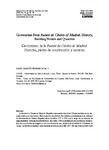Geotourism from Fuente de Cibeles of Madrid. History, Building Stones and Quarries

View/
Use this link to cite
http://hdl.handle.net/2183/27853
Except where otherwise noted, this item's license is described as Atribución-CompartirIgual 4.0 Internacional (CC BY-SA 4.0)
Collections
Metadata
Show full item recordTitle
Geotourism from Fuente de Cibeles of Madrid. History, Building Stones and QuarriesAlternative Title(s)
Geoturismo de la Fuente de Cibeles de Madrid. Historia, piedra de construcción y canterasAuthor(s)
Date
2020-12-28Citation
Freire-Lista, D. M. (2020). Geotourism from Fuente de Cibeles of Madrid. History, Building Stones and Quarries. Cadernos do Laboratorio Xeolóxico de Laxe. Revista de Xeoloxía Galega e do Hercínico Peninsular, 42, 69-94. https://doi.org/10.17979/cadlaxe.2020.42.0.7286
Abstract
[Abstract] Fuente de Cibeles of Madrid (Spain) represents Cybele goddess sitting on a carriage drawn by two lions. This sculptural set was carved in Montesclaros (Toledo-Spain) marble between 1777 and 1782. The sculptural set has experienced some modifications throughout its history. Two zoomorphic water-spouts carved in Colmenar de Oreja limestone, one in the shape of a dragon and another one in the shape of a bear, were installed in 1798. In 1895, the fountain changed of location, and two putti of Carrara marble were installed on the back of the fountain, expanding the rocky surface promontory on which the sculptural set stands. Two tiered basins made of granite were added in 1968, when the fountain acquired its current form.A geotouristic route was created based on Fuente de Cibeles and its main building stone, Montesclaros marble. An exhaustive description of the fountain was made, and its construction history was reviewed to elaborate the route. In this way, alternatives that diversify the conventional tourist options of the city of Madrid are presented. In addition, scientific data on historical quarries and the marble that forms part of the emblematic fountain is provided. [Resumen] La fuente de Cibeles de Madrid (España) representa a la diosa Cibeles sentada en un carruaje tirado por dos leones. Este conjunto escultórico fue tallado principalmente en mármol de Montesclaros (Toledo-España) entre los años 1777 y 1782 y a lo largo de su historia ha experimentado diversas modificaciones. En el año 1798 se instalaron dos surtidores zoomorfos, uno con forma de dragón y otro con forma de oso, tallados en la caliza de Colmenar de Oreja. La fuente se trasladó unas decenas de metros en el año 1895. En esa obra se elevó todo el conjunto escultórico y se instalaron dos putti de mármol de Carrara en la parte de atrás del carruaje, ampliando la superficie del promontorio rocoso sobre el que se asienta el conjunto escultórico. La fuente adquirió su forma actual en el año 1968; cuando se añadieron dos vasos escalonados de granito.A partir de la Fuente de Cibeles y su principal piedra de construcción, el mármol de Montesclaros, se creó una ruta geoturística. Una descripción exhaustiva, las fases de construcción y alteraciones de la fuente se presentan para completar la ruta por Montesclaros y zonas cercanas. De esta forma, se crean alternativas que diversifican las opciones turísticas convencionales de la ciudad de Madrid. Además, se aportan datos científicos sobre las canteras históricas y el mármol que forma parte de la emblemática fuente.
Keywords
Geoheritage
Montesclaros marble
Petrography
Heritage stones
Cybele
Patrimonio geológico
Mármol de Montesclaros
Petrografía
Cibeles
Montesclaros marble
Petrography
Heritage stones
Cybele
Patrimonio geológico
Mármol de Montesclaros
Petrografía
Cibeles
Editor version
Rights
Atribución-CompartirIgual 4.0 Internacional (CC BY-SA 4.0)
ISSN
2173-6936
0213-4497
0213-4497






